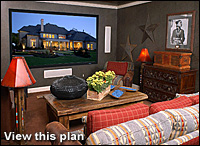
.png)
Search By Square Foot
• Up to 1000 Sq Ft
• 1001 - 1500 Sq Ft
• 1501 - 2000 Sq Ft
• 2001 - 2500 Sq Ft
• 2501 - 3000 Sq Ft
• 3001 - 3500 Sq Ft
• 3501 - 4000 Sq Ft
• 4001 - 4500 Sq Ft
• 4501 - 5000 Sq Ft
• 5001 Sq Ft And Up
Search By Square Foot
• Up to 1000 Sq Ft
• 1001 - 1500 Sq Ft
• 1501 - 2000 Sq Ft
• 2001 - 2500 Sq Ft
• 2501 - 3000 Sq Ft
• 3001 - 3500 Sq Ft
• 3501 - 4000 Sq Ft
• 4001 - 4500 Sq Ft
• 4501 - 5000 Sq Ft
• 5001 Sq Ft And Up
 A big trend during the building of a new home these days is creating a home theater. The possibilities are virtually limitless when it comes to the technologies and accessories available to create a home theater.
A big trend during the building of a new home these days is creating a home theater. The possibilities are virtually limitless when it comes to the technologies and accessories available to create a home theater.
Home theater is difficult to define because in actuality it's really just a vague term for how you approach home entertainment. Generally speaking, a home theater system is a combination of electronic components designed to recreate the experience of watching a movie in a theater. The image and the sound, together with the right equipment, can create the ultimate home theater experience.
If you're looking to design a home theater system, you have a lot of decisions to make. First youʼll need to decide what room you want to install your home theater and how far you want to go. Turning a family room or flexible space into a media/TV room is a lot different than creating a fully functional home theater.
Once youʼve decided the level of home entertainment you want from your new home, then you can begin to select the necessary components to create your own personal home theater. What you choose for your home theater system will depend on how much money you are willing to allot to this space and how important certain areas of performance are to you. So whether you are planning on spending $500 or $50,000 you should spend time understanding what each component does, so you can choose the right equipment to satisfy your audio and visual needs.
Basic Home Theater Components
The basic necessities to create your home theater are a 27-inch or larger television, movie playing device (DVD is recommended), speakers, a surround sound capable stereo receiver, all the cables and connectors and a high-quality surge protector. Since you are building anew home, it is a good idea to spend a little extra money for better quality equipment. Remember, you get what you pay for.
See our article about individual components.
Tips for setting up the system
The important thing to remember when you start with your home theater is that you want it to feel as close to a real movie cinema experience as possible. Put the system front and center at eye level, rather than off to the side. Sound travels better from the speakers if they are mounted on a wall or set on stands, not on top of bookshelves or cabinets. The three front speakers should be aligned with the television screen and the two in the rear should be one on each side of the listener just a little above ear level.
If you must stack the equipment, leave a minimum of 8 inches between them and the wall to allow for ventilation and easy installation. The receivers will create the most heat so put them on top of the stack or better yet, on their own shelf.
Power cords can cause interference and decreased signal quality for cables and wires. Don't bundle your wires and cables or place them close to the power cords. A notable tip, test your speakers before you trim the speaker wire to avoid cutting them to short and finding that you don't like the sound and have to move them.